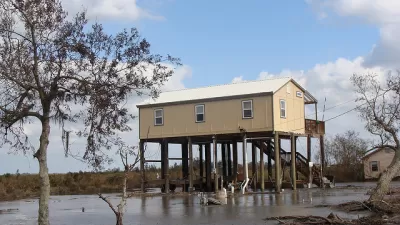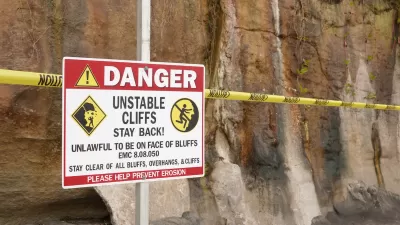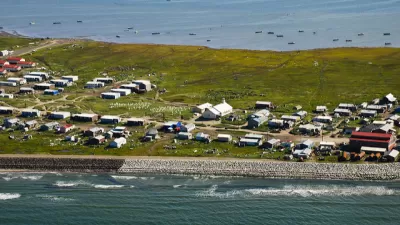A change of nomenclature shifts focus to the self-determination of residents relocating from the coast of Louisiana as rising seas inundate their homes.

Matthew D. Sanders writes of Isle de Jean Charles, a remote island community along the furthest stretches of southeastern Terrebonne Parish in Louisiana:
This is the setting of the first federally funded, climate-change induced community resettlement project—a $48.3 million effort to create a model for managed retreat at a scale not previously attempted. The Island is disappearing and this federal investment will ultimately determine whether the Island community disappears along with it, or whether it can experience a rebirth in a higher, drier, upland location.
A key message portrayed in this article, compared to previous media coverage of the Isle de Jean Charles resettlement project, addresses a question of nomenclature. Instead of "climate change refugees," planners working on the project prefer the term "climate change pioneers."
"They’re not refugees," writes Sanders. "They are pioneers who have willingly volunteered to take a proactive approach in the face of the sobering reality that the Island—their Island—will not withstand the impacts of future storms yet to come." That pioneering spirit is evident in the work residents are putting into the project, "collaborating with a project team of state officials, planners, engineers and architects to plan the look, feel, function and composition of the new community, but also to outline an appropriate and dignified 'long goodbye' for their Island."
FULL STORY: Don’t Label Them Climate Change Refugees, Says a Louisiana Planner, They’re Pioneers

Maui's Vacation Rental Debate Turns Ugly
Verbal attacks, misinformation campaigns and fistfights plague a high-stakes debate to convert thousands of vacation rentals into long-term housing.

Planetizen Federal Action Tracker
A weekly monitor of how Trump’s orders and actions are impacting planners and planning in America.

San Francisco Suspends Traffic Calming Amidst Record Deaths
Citing “a challenging fiscal landscape,” the city will cease the program on the heels of 42 traffic deaths, including 24 pedestrians.

Defunct Pittsburgh Power Plant to Become Residential Tower
A decommissioned steam heat plant will be redeveloped into almost 100 affordable housing units.

Trump Prompts Restructuring of Transportation Research Board in “Unprecedented Overreach”
The TRB has eliminated more than half of its committees including those focused on climate, equity, and cities.

Amtrak Rolls Out New Orleans to Alabama “Mardi Gras” Train
The new service will operate morning and evening departures between Mobile and New Orleans.
Urban Design for Planners 1: Software Tools
This six-course series explores essential urban design concepts using open source software and equips planners with the tools they need to participate fully in the urban design process.
Planning for Universal Design
Learn the tools for implementing Universal Design in planning regulations.
Heyer Gruel & Associates PA
JM Goldson LLC
Custer County Colorado
City of Camden Redevelopment Agency
City of Astoria
Transportation Research & Education Center (TREC) at Portland State University
Jefferson Parish Government
Camden Redevelopment Agency
City of Claremont





























